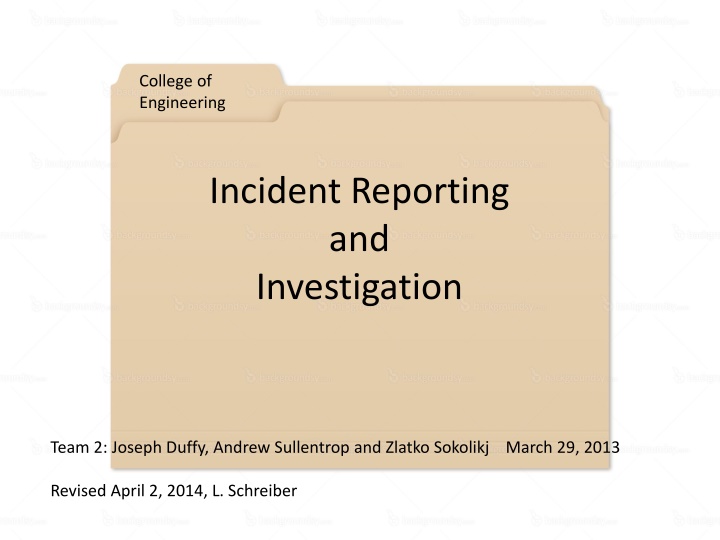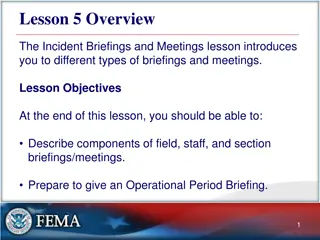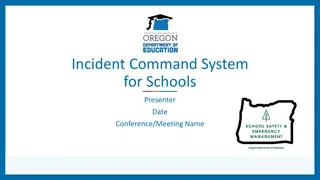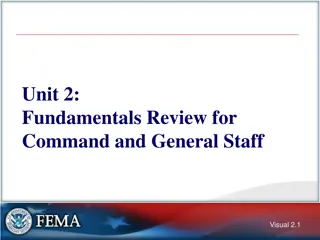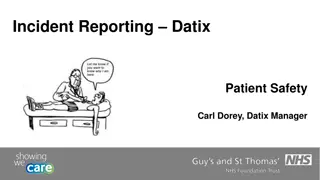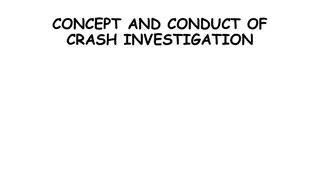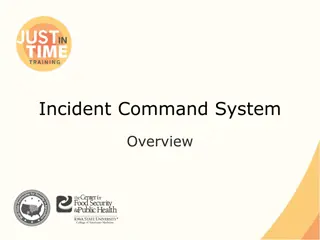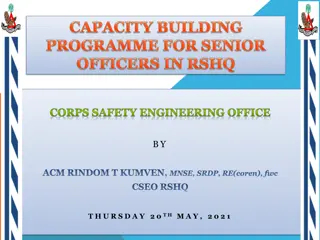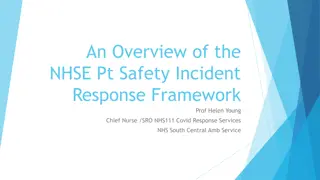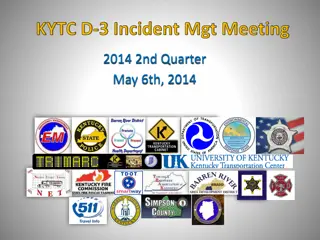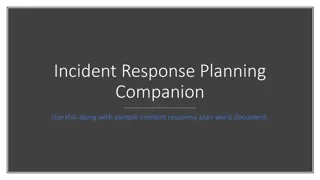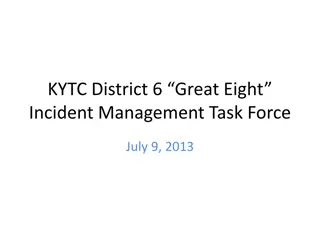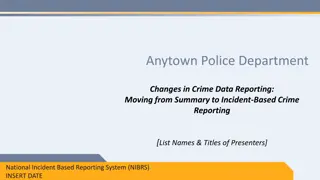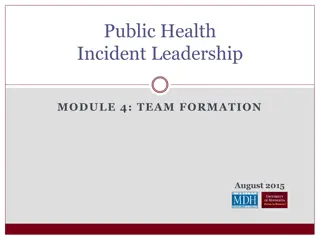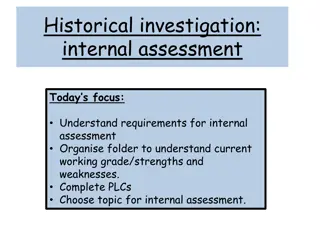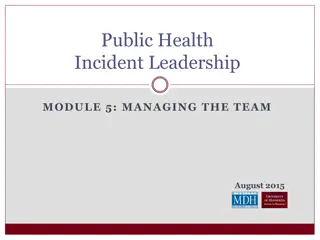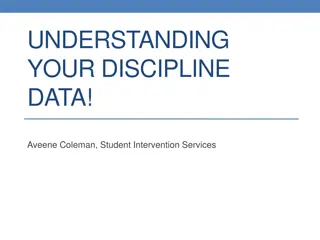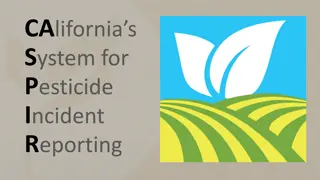College of Engineering Incident Reporting and Investigation Team
Incident reporting and investigation processes are crucial in maintaining safety standards in engineering environments. Understanding the distinctions between incidents and accidents, as well as the importance of reporting and containing them promptly, is vital for preventing reoccurrences. The investigation phase helps identify root causes and implement corrective measures, enhancing overall safety protocols within the institution. Proper documentation and reporting are emphasized to ensure compliance with legal requirements and facilitate continuous improvement in safety practices.
Download Presentation

Please find below an Image/Link to download the presentation.
The content on the website is provided AS IS for your information and personal use only. It may not be sold, licensed, or shared on other websites without obtaining consent from the author.If you encounter any issues during the download, it is possible that the publisher has removed the file from their server.
You are allowed to download the files provided on this website for personal or commercial use, subject to the condition that they are used lawfully. All files are the property of their respective owners.
The content on the website is provided AS IS for your information and personal use only. It may not be sold, licensed, or shared on other websites without obtaining consent from the author.
E N D
Presentation Transcript
College of Engineering Incident Reporting and Investigation Team 2: Joseph Duffy, Andrew Sullentrop and Zlatko Sokolikj March 29, 2013 Revised April 2, 2014, L. Schreiber
Incident or Accident - Although both of the terms incident and accident are used to describe any unforeseen occurrence in the lab, regardless of the severity, the National Safety Council has defined the appropriate boundaries in which these terms are used. NEAR MISS - describe incidents where no property was damaged and no personal injury sustained, but where, given a slight shift in time or position, damage and/or injury easily could have occurred. - an unplanned, undesired event that adversely affects completion of a task INCIDENT - an undesired event that results in personal injury or property damage. Accident
Contain the Accident/ Incident - After an accident has occurred, the first thing to do is to contain the accident making sure it can no longer cause more harm to the already injured or others & so that it cannot evolve into something more serious - ENSURE any injured personnel is receiving medical attention - ENSURE that any hazards generated by this accident have been contained or removed - REMOVE the equipment and any other items associated with the accident/incident out of access, so they may not cause harm to other operators in the vicinity - ENSURE that all the proper agencies have been informed
Report all accidents/incidents !!! - no matter how insignificant the damage or how evident the cause, all accidents must be reported WHY? What you don t report, you can t investigate. Legal requirements. Develop database of incident reporting and investigation history for future analysis. Identify problems in the operation before they lead to major incidents. To Whom? Where? - Specified Incident/Accident report form - Appropriate Authority
The Investigation WHY? To recognize the unsafe acts and/or conditions that caused the incident. To identify the management system that failed to prevent it from happening. To recommend remedial actions that will prevent it from happening again. WHO? - The team that performs the investigation is composed by the governing authority and may consist of an expert that has demonstrated knowledge in the field in which this incident falls onto
The Evidence - effective preservation of evidence is the key building block to a successful investigation. The Four types of Evidence (The four P s) Position Evidence describes the position of each apparatus at the time of the occurrence of the incident/accident. As the positions of the apparatuses might change after the experiment, it is the most fragile of all evidence and therefore should be gathered as soon as possible after an incident has occurred. - There are several easy ways to record position evidence photographs position maps
People evidence - is the second most fragile type of evidence we can gather in an incident / investigation. - The primary method we use for gathering people evidence is personal interviews. - Relevant information is not restricted to the incident itself, but includes the standards and practices of the work group, the normal operating conditions and any past incidents of a similar nature. An interviewer should be able to extract useful information of that nature. - People's ability to remember details regarding a situation diminishes quickly; therefore it is imperative that witnesses are interviewed as quickly as possible. - In addition, most people are not trained observers. They tend to interpret or rationalize what they have seen and fill in missing gaps with assumptions or pieces of information they have heard from others associated with the incident.
Interviewing People Interview one individual at a time (one on one). Neutral, private setting. Depersonalize. Use open-ended questions to gather information. Use close-ended questions to confirm information. Follow; don t lead. Listen and record; do not comment. Encourage follow-up.
Parts Evidence - Parts must be retrieved, labeled, and protected against damage so that analyses can be conducted. - All too often critical parts are thrown away or damaged, resulting in the loss of valuable evidence. - If a part is moved, it first should be photographed where it was found and then placed in an appropriate container. - Each part should be labeled to identify what it is and where it was found. - This also applies to material or liquid that has been spilled or discharged as a result of the incident. - It is important to be careful when handling these parts and materials, as fractured surfaces may be jagged or spilled material may be hazardous.
Paper Evidence - Paper evidence is the least fragile of all types of evidence. - Most paper evidence will be available for analysis several days or weeks after the incident. - Some computer evidence, such as process data, will need to be retrieved soon after an incident has occurred, as these systems often download or dump data every twenty-four hours.
Incident/Accident Analysis - Once all the evidence has been gathered, it can be analyzed using different models of Accident/Incident Analysis Models of Incident/Accident Analysis - Root Cause Analysis - Incident Trajectory Model
Root Cause Analysis - Is an approach for identifying the underlying causes of why an incident occurred so that the most effective solutions can be identified and implemented. - Typically used when something goes badly, but can also be used when something goes well. Within an organization, problem solving, incident investigation and root cause analysis are all fundamentally connected by three basic questions: - What's the problem? - Why did it happen? - What will be done to prevent it?
Multiple Root Causes The word root, in root cause analysis refers to the causes that are beneath the surface. Most organizations mistakenly use the term "root cause" to identify the one, main cause. Focusing on a single cause can limit the solutions set, resulting in better solutions being missed. The root is the system of causes that reveals all of the different options for solutions.
Simple Example Worker falls off ladder Ladder Worker Absence of Inspection Absence of training Misinformed Employee Lacking Operational Readiness or Physical Strength Prevention: - mandatory physical training - more regular inspections - proper distribution of hazards related information - clear definition of responsibilities
References - Incident/ Accident Investigation and Root Cause Analysis NPC Training Program Student Handout by Ron Rosser and Mike Breward - Think Reliability - Root Cause Analysis http://www.thinkreliability.com/Root-Cause-Analysis-CM-Basics.aspx - http://www.osha.gov/SLTC/etools/safetyhealth/mod4_factsheets_accinves t.html
